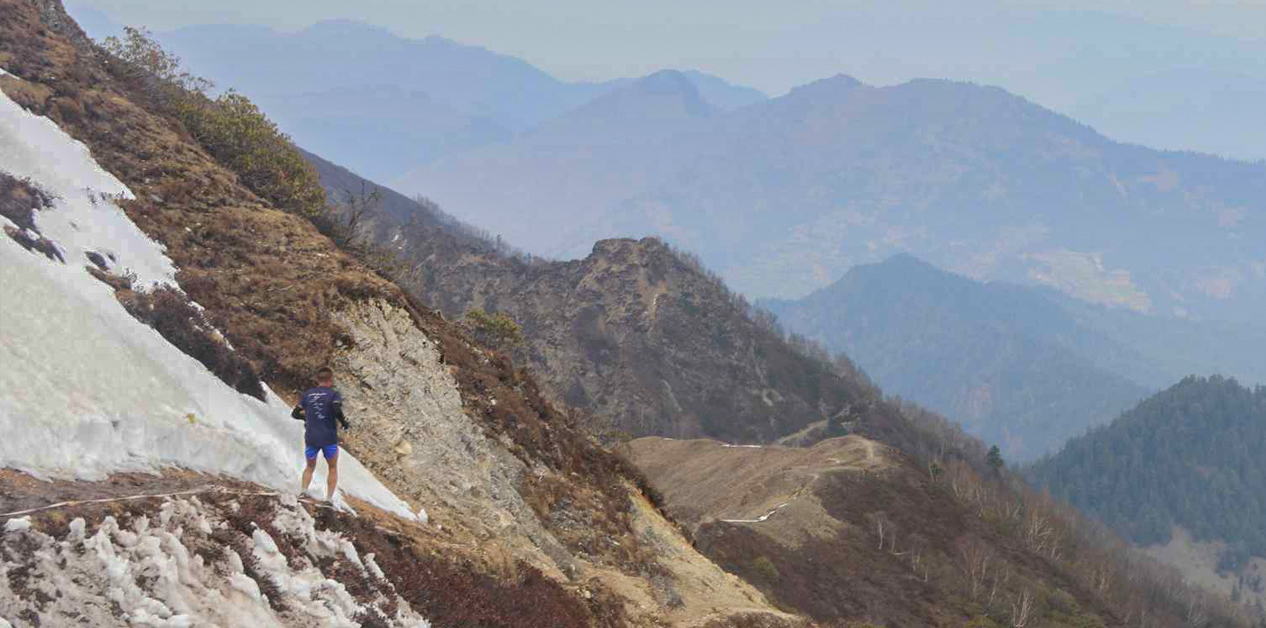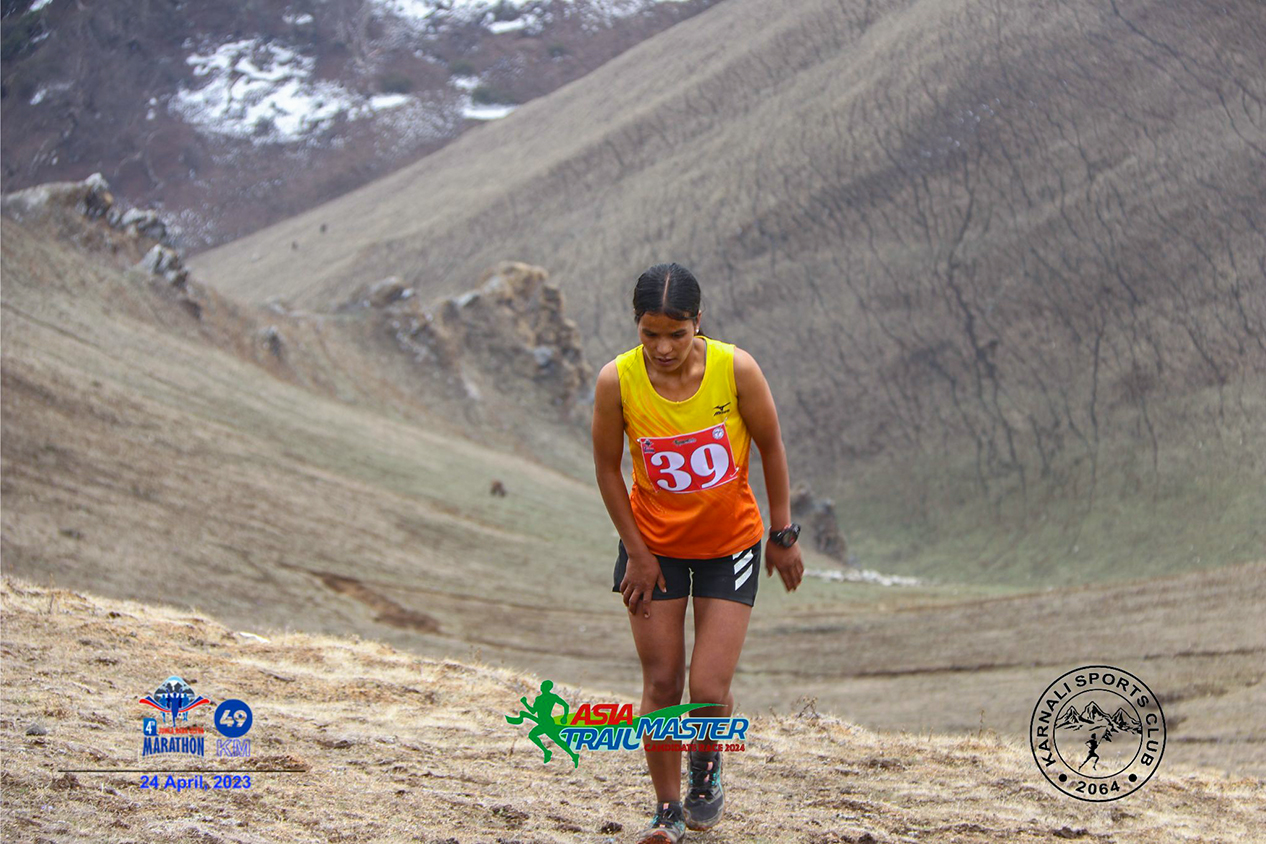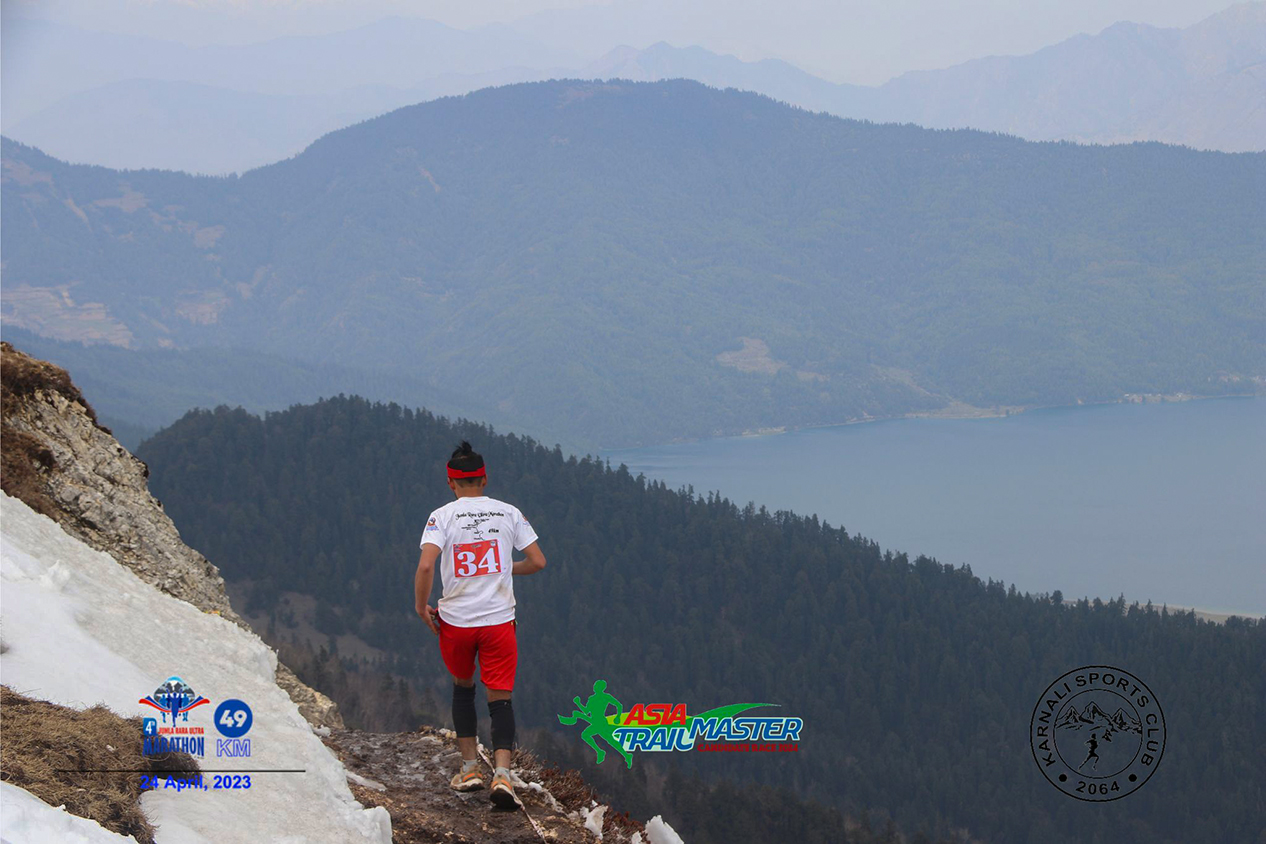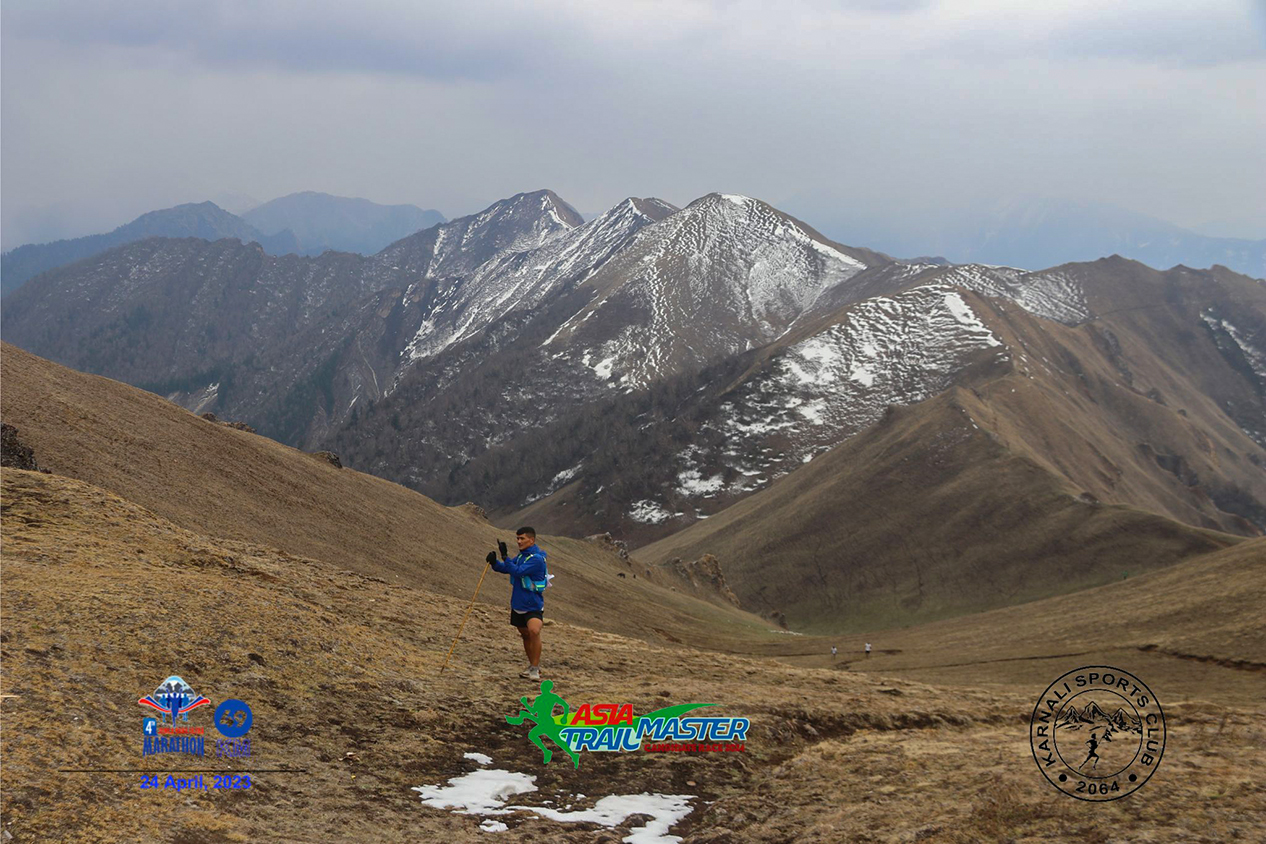

The sun in Jumla hadn’t even risen yet. Runner Kalpana Budha was sprinting in Rajasingh Chaur, Chandannath Municipality-5, raising dust from the ground with her tattered old shoes.
In less than two years of running, she has won medals in over a dozen national competitions, including the Manjushree Trail. Her current goal is to become an international runner like Sunmaya Budha.
But right now, her practice starts and ends in the same place. The training area is inadequate. Due to the lack of a track, vehicles, not players, enter the stadium. The distress of the dry season is the same: dust flies everywhere. During the rainy season, it’s just mud.
“I have heard that a Training Center is being built in Lotchaur,” she says, taking a deep breath, “But I don’t know when it will be finished.”
More than 60 million rupees has been spent so far in the name of constructing the training center. However, the delay in its construction has exacerbated land disputes with the school. Furthermore, nearly 50 ropanis of land have been reduced to a grazing field for livestock.
It has been eight years since the High-Altitude Training Center was first slated to be built at Lotchaur in Patarasi Rural Municipality-3, located at an altitude of 2,250 meters. But it is still not finished. The concept of building the training center was put forward in 2017. A Detailed Project Report (DPR) was prepared for the 55,000 square meter field to host more than two dozen sports, including football, volleyball, karate, basketball, athletics, boxing, and taekwondo.
Chimara Engineering Consultancy alone charged Rs 1 million for preparing the DPR. The DPR mentioned that a swimming pool, gender-friendly hostel, security guard quarters, guesthouse, and ticket counter would also be constructed.
Mahesh Dahal, the then-Secretary of the Ministry of Youth and Sports, had even monitored the necessary standards and geography for the field’s construction on December 19, 2017.
The report estimated a budget requirement of 320.3 million rupees. The school and local residents had freely donated the land to build the center. But for some reason, no work has progressed beyond leveling the ground.
From the perspective of producing athletes, Nepal’s geography is considered a place with extraordinary potential. The respiratory and lung capacity of young people living above 3,000 meters are naturally strong. For this reason, the government had proposed building a High-Altitude Training Center.

Fourth Jumla Rara Ultra Marathon. Photo courtesy: Karnali Sports Club
Bharat Budhthapa, a Central Member of All Nepal Football Association (ANFA) and a former football player from Jumla, says, “We thought that once the infrastructure was built, players would come not only from Nepal but also from abroad. We even celebrated with singing and dancing, believing that local products like Marsi rice, apples, Shilajit, and Yarsagumba would be sold. But now, only the work of leveling the ground has been done in the name of construction.”
More than 60 million rupees has been spent so far in the name of constructing the training center. However, the delay in its construction has exacerbated land disputes with the school. Furthermore, nearly 50 ropanis of land have been reduced to a grazing field for livestock.
In line with its policy and program, the government also included Bam Danda in Solukhumbu for the construction of a High-Altitude Training Center, similar to the one in Jumla. The situation here is no less challenging than in Jumla. About 100 ropanis of land were set aside for the training center nine years ago. If the center were built, it would allow practice for over two dozen sports, including football, cricket, volleyball, and swimming.
However, in another controversial decision, the government announced that the training center would be shifted from Bam Dada to Mappya Dudhkoshi Rural Municipality in Solukhumbu. The newly announced location lacks essential road access and suitable land. Narendra Thapa Magar, Chairman of the Solukhumbu District Sports Development Committee, says, “The center that is now planned to be built is close to Lukla Airport. It is very high up from the district headquarters. There is no road for vehicles.”
Nepal is also world-famous from a tourism perspective. If such training centers are built within the country, foreign players and teams can be attracted to practice here.
The Ministry of Sports had allocated 30 million rupees this year to build a center here. However, Chairman Thapa Magar, whose tenure is nearing completion, is not confident that the center will be built.
Why is a High-Altitude Training Center necessary in Nepal? Everyone may have their own arguments on this matter. However, it has become essential not just for the players but for the entire sports future of the country.
Nepal’s geography is considered unique and unparalleled in the world. Countries like Kenya, Ethiopia, and Morocco are leaders in producing world-class athletes by training in high-altitude areas like Nepal. These nations have been winning medals in the Olympics and World Championships for years.
They do have high-altitude regions, but not the same level of diversity as Nepal. Nepal has dozens of places with altitudes of 4,000 meters and above. Athletes representing the country from such places, like Sunmaya Budha and Ramamaya Budha from Jumla, Mira Rai from Bhojpur, and Priya Rai from Aiselukharka, Khotang, have already won medals in international competitions.

Fourth Jumla Rara Ultra Marathon. Photo courtesy: Karnali Sports Club
“If Nepal uses its natural geography for training, it would be highly beneficial. Players would utilize it and bring medals to the nation,” says Hari Bahadur Rokaya, a Nepali Olympian runner.
Most players reaching Nepal’s national team are now dependent on urban structures. Among them, Dasharath Stadium in Tripureshwar has become the primary training location for the majority. Most places have concrete structures.
The stadium has borne the burden of players since 1954. But now, that space has become cramped. Players have to wait their turn on the track while running. The practice hall is also small, limiting the number of players who can be trained. There are thousands of open fields in the villages. The talents there have never had the opportunity to run on a track or play on a field. He believes that if High-Altitude Training Centers are built in villages, they would not only be training grounds for youth but also open up employment opportunities.
Nepal is also world-famous from a tourism perspective. If such training centers are built within the country, foreign players and teams can be attracted to practice here. Foreign players from various nations go to Kunming in China’s Yunnan Province, Ooty in India, and Eldoret in Kenya for practice.
If such centers are built in places like Solukhumbu, Mustang, Jumla, and Dolakha, it would not only boost tourism but also revitalize the local economy. However, as these things remain limited to speeches, the country is being deprived of additional benefits.
Grand on paper, zero in implementation
The government’s slogan every year is to construct High-Altitude Training Centers. In the fiscal budget for 2075/76 (2018/2019), the government allocated 1 million rupees for the establishment and feasibility study of High-Altitude Training Centers.
After getting the ‘green signal’ from the government, the Ministry of Sports concluded that High-Altitude Training Centers could be built in high Himalayan regions like Solukhumbu, Manang, Jumla, Mustang, and Sindhupalchok. Since then, the Ministry has been regularly allocating a budget.
There are many complexities behind the delay in constructing projects like the High-Altitude Training Center in Nepal. These complexities are not only technical but are also related to politics and the balance of power.
When the government allocated a budget in 2017, 70 households in Timang and Thanchok villages of Manang, located at an altitude of 2,635 meters above sea level, were enthusiastic.
Villagers, eager to see their siblings, sons, and daughters-in-law play before their eyes, donated 30 ropanis of land to the government through the District Sports Development Committee for this work.
Encouraged by the villagers’ campaign, the District Development Committee also contributed 6 million, the Ministry of Sports 1.4 million, the ‘A’ Division League club Manang Marshyangdi 350,000, and the Annapurna Conservation Area (ACAP) 50,000 rupees. A DPR was prepared at a cost of 50 million rupees. But after this, the work did not proceed.
Shridhar Sharma, Member-Secretary of the Gandaki Province Sports Council, says, “Table work happens every year. Fieldwork is zero. The location is geographically suitable. But even though the location is right, a sufficient budget has not been secured. That is why the work has not moved forward.”
In the budget speech for 2022/2023, it was mentioned that such training centers would be built not only in Solukhumbu, Manang, Jumla, Mustang, and Sindhupalchok but also in Dolakha and Rukum Purba.
The then-Finance Minister Janardan Sharma surprised everyone by announcing that another training center would be built at Topla Patan in Jumla, allocating 10 million rupees for it. Previously, 11 million rupees had already been spent on preparing the DPR for Lotchaur in the same district. But Minister Sharma bypassed this and brought up a new concept for Topla Patan.

Fourth Jumla Rara Ultra Marathon. Photo courtesy: Karnali Sports Club
However, the following year, the then-Sports Minister Biraj Bhakta Shrestha countered Minister Sharma’s decision and went to Lotchaur to assure that the training center would be built there. He allocated 300 million rupees for it.
This year, the Ministry of Sports had proposed a budget of 70 million rupees to build High-Altitude Training Centers in four districts: Sindhupalchok, Rukum East, Dolakha, and Manang. However, the Ministry of Finance cut the budget for Sindhupalchok and Rukum East and allocated 100 million rupees to build High-Altitude Training Centers in Dolakha, Mustang, Jumla, and Solukhumbu.
The budget allocated by the Ministry includes 30 million for Mustang, 30 million for the Taekwondo High-Altitude Training Center being built in Shailung, Dolakha, 20 million to complete the training center in Jumla, and 20 million to advance the work of the center in Solukhumbu.
High-Altitude Training Centers seem normal to Nepali players. But many do not know its importance. For foreign coaches, however, it is considered essential and important.
Nepali national team’s head coach, Matt Ross, took players selected for the preliminary squad to Manang for five days of training before playing a friendly match against Hong Kong last April. Before leaving for Hong Kong, he said, “Hong Kong’s national stadium is a flat area near sea level.
Players will not face the challenge of altitude adaptation while playing there. But I conducted the training to work on endurance.” In the match held on June 10, Nepal held FIFA-ranked Hong Kong (28 places ahead) to a goalless draw.
Can’t build without budget: National Sports Council
There are many complexities behind the delay in constructing projects like the High-Altitude Training Center in Nepal. These complexities are not only technical but are also related to politics and the balance of power.
The National Sports Council (NSC) is responsible for planning sports projects. In the process, proposals are prepared based on priority after studying the need, potential, and status of the infrastructure. However, by the time that proposal moves from the NSC through the Ministry of Sports to the Ministry of Finance, it has often changed. Furthermore, priorities shift again when the budget is prepared.
Tanka Lal Ghising, Member-Secretary of the NSC, says, “The budget comes for things different from what the Council prioritized. How can work be done in such a situation? Another thing is that the size of the budget is small.”
The process of how plans are made in Nepal is as messy in practice as it appears organized on paper. A large budget is requested for large infrastructure projects. However, there is a tendency to fragment those budgets into small pieces based on political access. Member-Secretary Ghising says that this practice causes large infrastructure projects to take decades to complete.
“Sports projects change with every minister. The government is not stable, ministers are not long-lasting, and there is little understanding of what sports truly are,” he says. As Ghising mentioned, the problem with sports infrastructure is not solely determined by the size of the budget; the problem arises because the allocation is not based on actual priority.